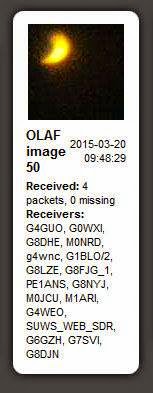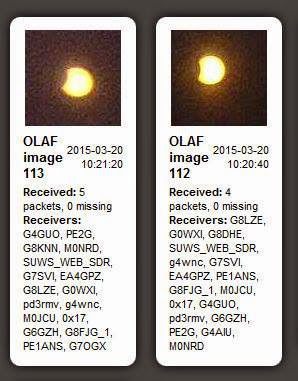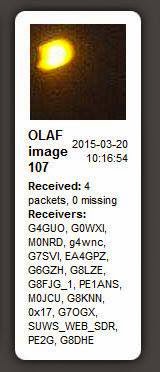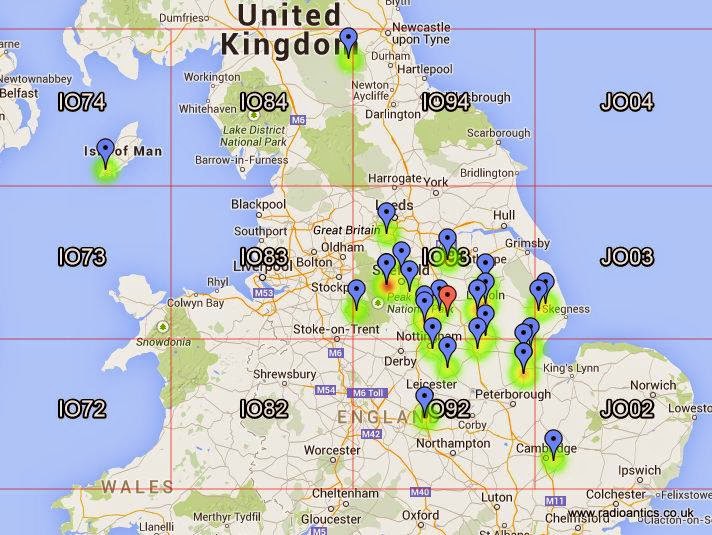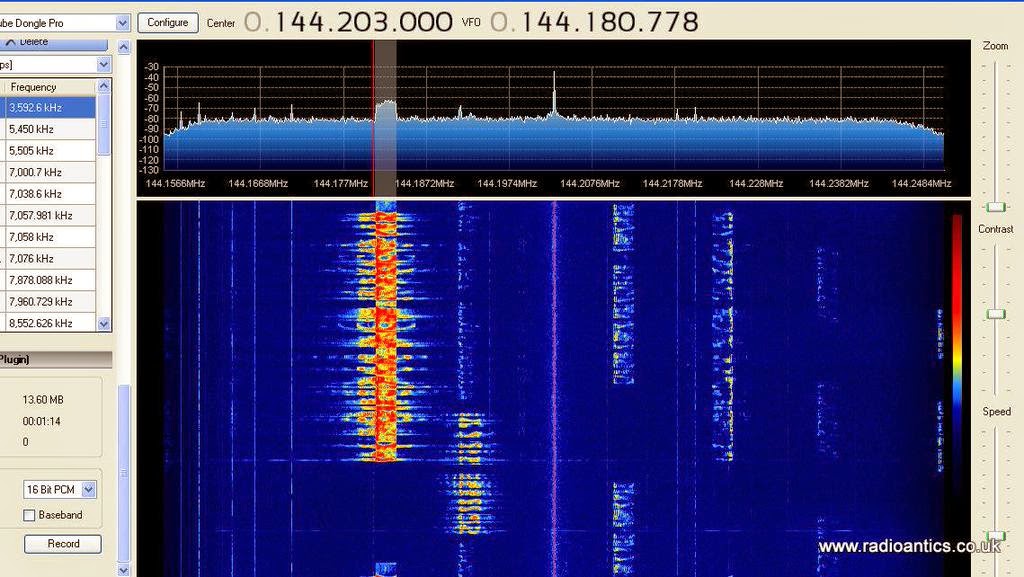Author Archive
 Some PMR fun
Some PMR fun
It was the Dambusters Hamfest on Sunday. Sadly the weather was awful with heavy rain all morning so was only there for an hour. Despite the flying visit I managed to pick up a couple of old PMR radios for conversion.
One is a Tait T535 2-Channel Mobile PMR which can be converted to amateur 2m operation relatively easily. Details are available on the internet including David Pye's website. I intend to use this unit to set up a permanent APRS internet gateway/digipeater.
While walking around with the Tait I attracted the attention of another seller who had some PYE MX294 units for sale. One was already converted to work on the 25kHz spaced simplex and repeater channels with CTCSS. The other was only partly converted and they came with a box full of spare boards and mounting plates and an original microphone and speaker. I wasn't really looking for any more units but seemed a bargain for £20.
The PYE MX294 was indeed converted and seemed to work fine on the simplex channels, and while it was receiving and transmitting on the repeater channels it wasn't transmitting the CTCSS sub-tone. With some sage information from Ian MW0IAN on twitter it was a simple issue to solve, using the oscilloscope I confirmed the tone was being generated it was the pot controlling the level that was set too low.
I have made a couple of QSOs with it and had some good audio reports. It is capable of 25W but has been set to 10w output so may increase this in time. Stewart M0SDM from the club was kind enough to video a QSO to illustrate the audio. Impressed by the quality of the unit I have ordered a second hand copy of the PMR Conversion Handbook as published by the RSGB from eBay so I can finish the the other MX294 as information on the net is a bit sketchy.
The Tait is proving a little more involved. It has a diode matrix board to set the Tx/Rx frequencies which has been set incorrectly. It also had a CTCSS board that was hard-wired in rather than socketed which I have now removed. The information of which diodes to link/unlink is freely available, however I decided to create a small windows utility to simplify the calculation. This is available for download from my website, it is supplied as is and with no warranty.
There are a number of modifications to add multi-channel to this radio by the use of eproms, but I am considering devising an Arduino solution to allow setting of frequencies and possibly selection of CTCSS.
 April Radio Antics
April Radio Antics
It has been an extremely busy month since my last post, sadly not all of it radio related.
During the Easter holiday I was away in the caravan at a dog agility show in North Yorkshire, camping in the grounds of Duncombe Park just outside Helmsley. When not competing I was able to find some time to operate.
Using just an M0CVO Magitenna I had some reasonable low power SSB operation on a number of bands and activated a square for the Worked All Britain Award (WAB) (SE58) and gave some points away during the Polish SP DX Contest.
The WAB scheme was something I signed up for last year when I went to Skye but haven't participated till now. The WAB net on 7.160MHz is a little daunting to listen too but once I jumped in it was relatively painless to activate the square and I plan to do some more when I go back to the Isle of Skye and Islay later this year, but I must improve my portable HF antenna.
Over the weekend of the 11/12th April there was another SSTV activation from the ISS in celebration of Yuri Gargarin's life. I had some good results decoding images and decided that I'd use it as a way to promote South Kesteven ARS locally and contacted the local newspaper.
The Newark Advertiser did indeed feature the story both in print and on their website and they were very good in mentioning the radio society. It was also printed in the sister free paper.
It was nice to get some very complimentary reaction to my publicity drive in social media and other websites including an article on the Amsat-UK page http://amsat-uk.org/2015/04/15/iss-sstv-in-the-press/
Last weekend I and other members of the South Kesteven Amateur Radio Society operated the special event station GB5ROC at the Buckminster Cold War Royal Observer Corps (ROC) Nuclear Bunker Open Day.
Situated on the Lincolnshire/Leicestershire border ROC Post Number 62 is leased to the UP AN’ AT EM! History project and has been restored as a museum and is managed by Jed Jaggard. The free open day was a rare chance to visit and experience an important part of British post-war history.
These bunkers are underground structures found all over the United Kingdom, constructed as a result of the Corps’ civil defence nuclear reporting role and were operated by volunteers during the Cold War between 1955 and 1991. There was a network of over 1500 such monitoring posts around the UK designed to detect nuclear detonations and monitor blast and subsequent fallout and radiation levels should an attack take place.
Thankfully they were never used and the last of the posts were closed in 1991 when the majority of the ROC was stood down following the break-up of the Communist Bloc. Many have been demolished, fill in or adapted to other uses but the majority still exist, although in a derelict condition.
During the open day visitors had the chance to climb down into the bunker so for reasons of practicality SKARS operated GB5ROC from a tent close to the bunker hatch.
Along with Stewart Mason (M0SDM) and Sean Burton (2E0ENN) we operated on 40m from 10:00 till 16:30 BST and made a total of 151 contacts mostly UK operators with a number of European stations.
Equipment was supplied by Stewart who did the majority of the operating and consisted of a Yaesu FT-897D at 100W feeding an off centre fed dipole at around 30ft on top of a Racal push up mast. Stewart also provided a new club banner.
The open day was very well attended and a number of local and not so local amateurs (one visitor from Australia VK4UA ) came along thanks to the publicity the event had received on Facebook, Twitter, GB2RS and the Southgate ARC newsfeed. It was great to meet up and chat.
Encouragingly members of the general public were keen to learn what amateur radio was all about and they were able to take away a number of leaflets with information about the hobby and contact details for SKARS.
It was an excellent day all round with the operators have a fun time and gaining useful experience of operating a pile-up. The weather was kind with blue skies and sunshine. Hopefully it will become a regular activation at future bunker activations.
The video below Stewart operating Richard M6GPT who had tried most of the day to make contact and was successful just before the station was closed down.
SKARS member Mark (M0OBL) had monitored GB5ROC and made a video of his Elecraft K2 receiving us load and clear.
Next month is going to be very busy as I have GB2EGG and the Eggsplorer-1 HAB flight to organise and that too has made the press. http://www.sleafordtarget.co.uk/Egg-sent-space-World-Egg-Throwing-Championships/story-26372439-detail/story.html
Oh and lastly remember this is the original "Radio Antics" blog, often imitated but never bettered.. 73
Update, the visit of VK4UA to GB5ROC wasn't due to any publicity or advertising - it was simply because Stewart had his van parked on the verge with his callsign clearly visible and he was visiting the area - the simplest ideas are the best it seems!
During the Easter holiday I was away in the caravan at a dog agility show in North Yorkshire, camping in the grounds of Duncombe Park just outside Helmsley. When not competing I was able to find some time to operate.
 |
| Boris combining both hobbies! |
Using just an M0CVO Magitenna I had some reasonable low power SSB operation on a number of bands and activated a square for the Worked All Britain Award (WAB) (SE58) and gave some points away during the Polish SP DX Contest.
The WAB scheme was something I signed up for last year when I went to Skye but haven't participated till now. The WAB net on 7.160MHz is a little daunting to listen too but once I jumped in it was relatively painless to activate the square and I plan to do some more when I go back to the Isle of Skye and Islay later this year, but I must improve my portable HF antenna.
Over the weekend of the 11/12th April there was another SSTV activation from the ISS in celebration of Yuri Gargarin's life. I had some good results decoding images and decided that I'd use it as a way to promote South Kesteven ARS locally and contacted the local newspaper.
The Newark Advertiser did indeed feature the story both in print and on their website and they were very good in mentioning the radio society. It was also printed in the sister free paper.
 |
| Copyright Newark Advertiser |
It was nice to get some very complimentary reaction to my publicity drive in social media and other websites including an article on the Amsat-UK page http://amsat-uk.org/2015/04/15/iss-sstv-in-the-press/
Situated on the Lincolnshire/Leicestershire border ROC Post Number 62 is leased to the UP AN’ AT EM! History project and has been restored as a museum and is managed by Jed Jaggard. The free open day was a rare chance to visit and experience an important part of British post-war history.
These bunkers are underground structures found all over the United Kingdom, constructed as a result of the Corps’ civil defence nuclear reporting role and were operated by volunteers during the Cold War between 1955 and 1991. There was a network of over 1500 such monitoring posts around the UK designed to detect nuclear detonations and monitor blast and subsequent fallout and radiation levels should an attack take place.
Thankfully they were never used and the last of the posts were closed in 1991 when the majority of the ROC was stood down following the break-up of the Communist Bloc. Many have been demolished, fill in or adapted to other uses but the majority still exist, although in a derelict condition.
During the open day visitors had the chance to climb down into the bunker so for reasons of practicality SKARS operated GB5ROC from a tent close to the bunker hatch.
Along with Stewart Mason (M0SDM) and Sean Burton (2E0ENN) we operated on 40m from 10:00 till 16:30 BST and made a total of 151 contacts mostly UK operators with a number of European stations.
Equipment was supplied by Stewart who did the majority of the operating and consisted of a Yaesu FT-897D at 100W feeding an off centre fed dipole at around 30ft on top of a Racal push up mast. Stewart also provided a new club banner.
The open day was very well attended and a number of local and not so local amateurs (one visitor from Australia VK4UA ) came along thanks to the publicity the event had received on Facebook, Twitter, GB2RS and the Southgate ARC newsfeed. It was great to meet up and chat.
Encouragingly members of the general public were keen to learn what amateur radio was all about and they were able to take away a number of leaflets with information about the hobby and contact details for SKARS.
It was an excellent day all round with the operators have a fun time and gaining useful experience of operating a pile-up. The weather was kind with blue skies and sunshine. Hopefully it will become a regular activation at future bunker activations.
The video below Stewart operating Richard M6GPT who had tried most of the day to make contact and was successful just before the station was closed down.
SKARS member Mark (M0OBL) had monitored GB5ROC and made a video of his Elecraft K2 receiving us load and clear.
Next month is going to be very busy as I have GB2EGG and the Eggsplorer-1 HAB flight to organise and that too has made the press. http://www.sleafordtarget.co.uk/Egg-sent-space-World-Egg-Throwing-Championships/story-26372439-detail/story.html
Oh and lastly remember this is the original "Radio Antics" blog, often imitated but never bettered.. 73
Update, the visit of VK4UA to GB5ROC wasn't due to any publicity or advertising - it was simply because Stewart had his van parked on the verge with his callsign clearly visible and he was visiting the area - the simplest ideas are the best it seems!
 FT-450D First impressions
FT-450D First impressions
My first rig the Yaesu FT-857D has proved a more than capable radio and as a shack in a box covering HF-VHF-UHF it is excellent and has allowed me to try my hand at most things since becoming licensed but I wanted a dedicated HF set up that was a bit less fiddly to use.
So last month I succumbed to temptation and ordered a Yaesu FT-450D. While it is still an entry level rig I had heard good things about it and liked the look and feel of it. Martin Lynch & Sons had them at a low price and combined with Yaesu's 'Late Winter Warmer 2015' cash-back promotion made it an opportunity I didn't want to miss.
It arrived last week but I only got to properly have a play this weekend even then not for as long as I really would have wanted. I know people might detest HF contests but I was quite glad of the CQ WPX to try out the radio with plenty of contacts on 10/15/20 and 40m while keeping the output below 50W.
I have still to work out all the settings and the DSP functions but first impressions are of an excellent receiver with good tone and clear audio from the internal speaker. Being a very popular contest the bands were crowded at the weekend but I had no trouble picking out weaker stations even with very strong adjacent stations. Using the supplied microphone and the default processing settings I had no issue getting out either, working nearly all of the stations I called.
I have previously used a manual ATU and found the internal ATU is a nice feature when switching bands and it did a excellent job of fine tuning the M0CVO OCFD. It couldn't tune it on 40m directly as the VSWR was greater than 3:1 so had to revert back to the external ATU.
Only very minor gripe I had was the CAT connection, In my research I noted it was a standard RS232C 9-pin connector and assumed I would just plug in a standard PC serial lead, but I hadn't spotted the radio had a male connector not female!
I wanted to try out the CAT but hadn't got a gender changer or connectors in the shack to make up a lead. I did have a number of commercial RS232 extension leads moulded male connector one end, female the other, so chopped up two and spliced the appropriate halves together. It works fine with a USB-Serial adapter in Ham Radio Deluxe but refused to work with the Omnirig control used by PZTLog until I disabled the hardware handshaking.
Still early days and I do need to read the manual but more than happy with it.
So last month I succumbed to temptation and ordered a Yaesu FT-450D. While it is still an entry level rig I had heard good things about it and liked the look and feel of it. Martin Lynch & Sons had them at a low price and combined with Yaesu's 'Late Winter Warmer 2015' cash-back promotion made it an opportunity I didn't want to miss.
It arrived last week but I only got to properly have a play this weekend even then not for as long as I really would have wanted. I know people might detest HF contests but I was quite glad of the CQ WPX to try out the radio with plenty of contacts on 10/15/20 and 40m while keeping the output below 50W.
I have still to work out all the settings and the DSP functions but first impressions are of an excellent receiver with good tone and clear audio from the internal speaker. Being a very popular contest the bands were crowded at the weekend but I had no trouble picking out weaker stations even with very strong adjacent stations. Using the supplied microphone and the default processing settings I had no issue getting out either, working nearly all of the stations I called.
I have previously used a manual ATU and found the internal ATU is a nice feature when switching bands and it did a excellent job of fine tuning the M0CVO OCFD. It couldn't tune it on 40m directly as the VSWR was greater than 3:1 so had to revert back to the external ATU.
Only very minor gripe I had was the CAT connection, In my research I noted it was a standard RS232C 9-pin connector and assumed I would just plug in a standard PC serial lead, but I hadn't spotted the radio had a male connector not female!
I wanted to try out the CAT but hadn't got a gender changer or connectors in the shack to make up a lead. I did have a number of commercial RS232 extension leads moulded male connector one end, female the other, so chopped up two and spliced the appropriate halves together. It works fine with a USB-Serial adapter in Ham Radio Deluxe but refused to work with the Omnirig control used by PZTLog until I disabled the hardware handshaking.
Still early days and I do need to read the manual but more than happy with it.
 I am now the Chairman of a radio club!
I am now the Chairman of a radio club!
Firstly my apologies, last weeks post about the Eggciting Eggsplorer-1 HAB project and the talk and demonstration on SSDV wasn't posted on Amateurradio.com due to an error.
This week South Kesteven ARS (SKARS) held an EGM where I was voted on as the new Chairman. Nigel Booth M0CVO has stepped down following four years in the position citing increasing business commitments. Nigel intends to remain an active member, I and the other members wish to thank Nigel for his efforts over the years and wish him well with his business ventures.
SKARS has a small membership at present which we hope to increase but the committee finds itself in the Catch-22 position of not having a lot of funds in order to put on activities and promote ourselves to increase the membership.
I have created a social media presence in the form of a Facebook page and twitter account in addition to updating the societies web page.I am hoping that permission willing the GB2EGG and Eggsplorer-1 project will significantly promote the society and the hobby.
I know running a club/society isn't a trivial undertaking, especially if working full time having chaired a large dog agility training club many years ago. It can take a lot of effort and time and it can sometimes be a thankless task.
Indeed my first twenty-four hours has Chairman saw my first sacrifice, a lovely Yaesu FT-450D was delivered yesterday and I have yet to take it out of the box!
Something to be remedied this evening.
This week South Kesteven ARS (SKARS) held an EGM where I was voted on as the new Chairman. Nigel Booth M0CVO has stepped down following four years in the position citing increasing business commitments. Nigel intends to remain an active member, I and the other members wish to thank Nigel for his efforts over the years and wish him well with his business ventures.
SKARS has a small membership at present which we hope to increase but the committee finds itself in the Catch-22 position of not having a lot of funds in order to put on activities and promote ourselves to increase the membership.
I have created a social media presence in the form of a Facebook page and twitter account in addition to updating the societies web page.I am hoping that permission willing the GB2EGG and Eggsplorer-1 project will significantly promote the society and the hobby.
I know running a club/society isn't a trivial undertaking, especially if working full time having chaired a large dog agility training club many years ago. It can take a lot of effort and time and it can sometimes be a thankless task.
Indeed my first twenty-four hours has Chairman saw my first sacrifice, a lovely Yaesu FT-450D was delivered yesterday and I have yet to take it out of the box!
Something to be remedied this evening.
 Eggciting HAB projects
Eggciting HAB projects
I have a new high altitude balloon project, this one is very Eggciting.
In June my club South Kesteven Amateur Radio Society (SKARS) will be operating a special event station at the Swaton Vintage Day held at Thorpe Latimer in Lincolnshire.
The 2015 Swaton Vintage Day will also host the 10th World Egg Throwing Championship and in recognition the special event station will have the call sign GB2EGG. This popular annual show raises money for local, national and international good causes.
Egg Throwing is recognised by the English Sports Council and the sport is taken very seriously by some competitors. Hundreds of competitors from Europe and around the world are expected to compete this year. Last year’s event attracted teams from Germany, Slovenia, Hong Kong and Brazil.
While planning the special event station I jokingly suggested throwing an egg in to space on board a balloon, I shouldn't have yoked as it is now a serious project. The idea coming from Dave Akerman's Spudnik flight for Heston Blumenthal’s Channel4 television program.
Subject to Civil Aviation Authority clearance and weather conditions I will hopefully launch a high altitude balloon carrying one lucky egg into the edge of space and then dropping it back to earth under a parachute. In addition to the plucky Eggstronaut the balloon I have called Eggsplorer-1 will carry a radio transmitter to broadcast its position, altitude and live images of the journey back to earth.
On board cameras will record the journey to be recovered on a successful return to Earth. Radio enthusiasts all around the country will be able to assist receiving the data and pictures and track the progress of the flight via the UK High Altitude Society tracking website.
More details and progress will be posted on here and on the Eggsplorer-1 website and you can follow developments on twitter @eggsplorer1South Kesteven ARS welcomes anybody with an interest in radio communications, so if want to be involved in this and other events like this please visit us at the show or visit the South Kestevan ARS website and on twitter @M0SKR
I have already begun development of the payload, unlike the moth-balled NERD-1 payload this one will use one of the Raspberry Pi boards since I want to transmit SSDV images live and it supports its own specially designed camera modules. NERD-1 will still fly as a backup tracker.
Dave Akerman (M0RPI) and Anthony Stirk (M0UPU) have developed the Pi-In-The-Sky ready made boards and the design and software are open-sourced, using this as a starting point together with Phil Heron's (MI0VIM) SSDV software I quickly had a prototype dubbed NERDPI running.
I did have an issue since the GPS module I currently have only outputs serial data so had to use one of those small TTL USB-Serial adapters and spun some of my own code to get the data out and was soon successfully decoding my own transmissions from the shack and uploading them to the Habhub system.
Today has seen the spectacular partial solar eclipse here in the UK, during the eclipse several HAB flights were launched to try to capture images above any cloud cover (details here) Fellow SKARS members and members from the Grantham ARC were keen to decode the SSDV images themselves as the BBC Stargazing Live balloons were flying from nearby Leicester.
So on Wednesday I did a talk and demonstration to show how to track and decode the images, it was well received and I uploaded pictures of the audience to the system.
Unfortunately technical issues prevented live images from the Stargazing HABs being transmitted but I was able to decode some images from the University of Southampton OLAF payload They were only lo-res but still pleased to get decodes here it was a good distance from me.
Here in Newark the sky was beautifully clear so the eclipse was visible and spectacular, where OLAF was flying was covered in cloud, so the mission was a success.
In June my club South Kesteven Amateur Radio Society (SKARS) will be operating a special event station at the Swaton Vintage Day held at Thorpe Latimer in Lincolnshire.
The 2015 Swaton Vintage Day will also host the 10th World Egg Throwing Championship and in recognition the special event station will have the call sign GB2EGG. This popular annual show raises money for local, national and international good causes.
Egg Throwing is recognised by the English Sports Council and the sport is taken very seriously by some competitors. Hundreds of competitors from Europe and around the world are expected to compete this year. Last year’s event attracted teams from Germany, Slovenia, Hong Kong and Brazil.
While planning the special event station I jokingly suggested throwing an egg in to space on board a balloon, I shouldn't have yoked as it is now a serious project. The idea coming from Dave Akerman's Spudnik flight for Heston Blumenthal’s Channel4 television program.
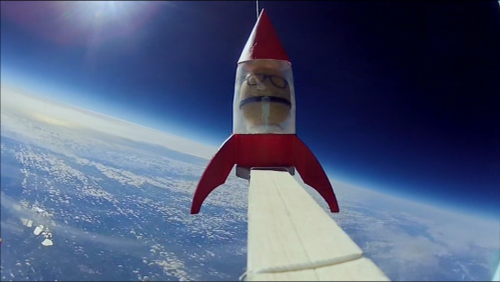 |
| Image with the permission of Dave Akerman |
On board cameras will record the journey to be recovered on a successful return to Earth. Radio enthusiasts all around the country will be able to assist receiving the data and pictures and track the progress of the flight via the UK High Altitude Society tracking website.
More details and progress will be posted on here and on the Eggsplorer-1 website and you can follow developments on twitter @eggsplorer1South Kesteven ARS welcomes anybody with an interest in radio communications, so if want to be involved in this and other events like this please visit us at the show or visit the South Kestevan ARS website and on twitter @M0SKR
I have already begun development of the payload, unlike the moth-balled NERD-1 payload this one will use one of the Raspberry Pi boards since I want to transmit SSDV images live and it supports its own specially designed camera modules. NERD-1 will still fly as a backup tracker.
Dave Akerman (M0RPI) and Anthony Stirk (M0UPU) have developed the Pi-In-The-Sky ready made boards and the design and software are open-sourced, using this as a starting point together with Phil Heron's (MI0VIM) SSDV software I quickly had a prototype dubbed NERDPI running.
I did have an issue since the GPS module I currently have only outputs serial data so had to use one of those small TTL USB-Serial adapters and spun some of my own code to get the data out and was soon successfully decoding my own transmissions from the shack and uploading them to the Habhub system.
Today has seen the spectacular partial solar eclipse here in the UK, during the eclipse several HAB flights were launched to try to capture images above any cloud cover (details here) Fellow SKARS members and members from the Grantham ARC were keen to decode the SSDV images themselves as the BBC Stargazing Live balloons were flying from nearby Leicester.
So on Wednesday I did a talk and demonstration to show how to track and decode the images, it was well received and I uploaded pictures of the audience to the system.
Here in Newark the sky was beautifully clear so the eclipse was visible and spectacular, where OLAF was flying was covered in cloud, so the mission was a success.
 A dark cold evening in a layby
A dark cold evening in a layby
True to my last post I drove out to some higher ground to operate portable for the 70cms UKAC on Tuesday evening.
Several hours sitting in the car on the side of a deserted road in the dark and cold was worth it. Despite some initial trepidation I really enjoyed the experience until I got spooked at the end.
Like the last time I operated from this location I put the small yagi approximately 3-4 metres up on the top of my 'painters' telescopic pole stuck in to a parasol stand. I sat in the car and reached out the open window to rotate the pole as required. I wrapped up well and had a blanket over my legs and a woolly hat on and kept surprising warm despite it being just 1°C, turning the courtesy light on only when I needed to write in the log.
It was nice to be noise free and I made 29 contacts, nothing earth shattering but with a modest set up and operating in the AL section (10W max) I was more than happy and got my first contact in the Isle of Man.
From the reports posted on line it seems conditions were flat and activity was low. Frustratingly several times I found a distant station only for it to be drowned out by splatter. I know some of this is down to my radio and the antenna but the source is nearby and so strong that even turning the beam makes little difference. Ironically being higher up meant the signal was even stronger than I experience at home.
The annoyance is compounded by the operator's habit of regularly changing calling frequency seemingly with little regard of who is currently operating there. This SDR screen capture shows an example of the same contesters signal during a recent 2m UKAC. Captured using a vertical collinear several strong clean(er) signals are clearly visible even with the mismatched polarisation. Sadly it is not a one-off and I have observed similar splatter from this source during both 70cms and 6m contests.
It was very dark and eerie on the quiet road and I'm afraid I got spooked with 20 minutes of the contest left, a 4x4 drove past slowly and appeared to shine a spotlight at my car. I was midway through a QSO writing in the logbook so I only caught it out of the corner of my eye so wasn't sure if they did. But a while later I saw what looked like torch beams moving in the nearby field that seemed to be getting closer. In retrospect it was nothing untoward when I checked the map later there are farm buildings in that direction but I've seen one too many horror films so decided not to hang about so threw everything in the car and headed home with out looking back..
Several hours sitting in the car on the side of a deserted road in the dark and cold was worth it. Despite some initial trepidation I really enjoyed the experience until I got spooked at the end.
Like the last time I operated from this location I put the small yagi approximately 3-4 metres up on the top of my 'painters' telescopic pole stuck in to a parasol stand. I sat in the car and reached out the open window to rotate the pole as required. I wrapped up well and had a blanket over my legs and a woolly hat on and kept surprising warm despite it being just 1°C, turning the courtesy light on only when I needed to write in the log.
It was nice to be noise free and I made 29 contacts, nothing earth shattering but with a modest set up and operating in the AL section (10W max) I was more than happy and got my first contact in the Isle of Man.
From the reports posted on line it seems conditions were flat and activity was low. Frustratingly several times I found a distant station only for it to be drowned out by splatter. I know some of this is down to my radio and the antenna but the source is nearby and so strong that even turning the beam makes little difference. Ironically being higher up meant the signal was even stronger than I experience at home.
The annoyance is compounded by the operator's habit of regularly changing calling frequency seemingly with little regard of who is currently operating there. This SDR screen capture shows an example of the same contesters signal during a recent 2m UKAC. Captured using a vertical collinear several strong clean(er) signals are clearly visible even with the mismatched polarisation. Sadly it is not a one-off and I have observed similar splatter from this source during both 70cms and 6m contests.
It was very dark and eerie on the quiet road and I'm afraid I got spooked with 20 minutes of the contest left, a 4x4 drove past slowly and appeared to shine a spotlight at my car. I was midway through a QSO writing in the logbook so I only caught it out of the corner of my eye so wasn't sure if they did. But a while later I saw what looked like torch beams moving in the nearby field that seemed to be getting closer. In retrospect it was nothing untoward when I checked the map later there are farm buildings in that direction but I've seen one too many horror films so decided not to hang about so threw everything in the car and headed home with out looking back..
you can't get rid of the Babadook
.... you'll see him if you look
.... you'll see him if you look
 Operating /P for the 432MHz UKAC tonight
Operating /P for the 432MHz UKAC tonight
The 432MHz UKAC contest is usually a pretty dismal experience for me, low elevation, local noise and a mediocre antenna makes for a difficult evening. Last weekends VHF/UHF contest and some tests with fellow club member Stewart (M0SDM) on Sunday evening convinced me to try operating portable this week.
I have a small Moonraker 7-element ZL-Special on the main antenna mast, purchased originally for monitoring satellites and was pressed into service for SSB when I got licensed. It has never wowed me performance wise and I have been intending to replace it for quite a while but since I only use it one day a month it hasn't been a priority. So the mast came down last night and I removed it so I can take it out with me to operate portable from some higher ground tonight.
Last year I had a go at operating portable from the car and posted a write-up. It is my intention to repeat this exercise but with the 70cm antenna on top of my 'painters pole' mast. I have serviced the antenna and fitted a new short run of quality coax and spent a far amount of time with the AW07A analyser adjusting the antenna's tuning capacitor and have got the VSWR right down to 1.1:1 on 432.200MHz so things should be optimal.
I am looking forward to this evening, hoping it pays some dividends.
As I mentioned the 24 hour March 144/432MHz VHF Championship contest took place last weekend. I took part to give away some points just grabbing a few short sessions with the radio. I concentrated on the 2m band due to my issues on 70cm.
In my AW07A analyser review I mentioned some issues with my 2m LFA YAGI, thankfully these have been resolved. The use of some wire wool to remove some corrosion and a hacksaw to take 10mm from the long elements of the loop allowed the end elements to 'trombone' in sufficiently to get the antenna resonant and the VSWR is down to 1.2:1 on 144.300Mhz.
I only made 18 contacts, but was happy with the distances achieved with 30W, getting a lot further south than I normally do, given I am 18m ASL. There was also some local wideband noise (I captured a screenshot on the SDR) and the conditions gave some interesting fading.
I have a small Moonraker 7-element ZL-Special on the main antenna mast, purchased originally for monitoring satellites and was pressed into service for SSB when I got licensed. It has never wowed me performance wise and I have been intending to replace it for quite a while but since I only use it one day a month it hasn't been a priority. So the mast came down last night and I removed it so I can take it out with me to operate portable from some higher ground tonight.
| Using the 2m delta beam in June 2014 |
Last year I had a go at operating portable from the car and posted a write-up. It is my intention to repeat this exercise but with the 70cm antenna on top of my 'painters pole' mast. I have serviced the antenna and fitted a new short run of quality coax and spent a far amount of time with the AW07A analyser adjusting the antenna's tuning capacitor and have got the VSWR right down to 1.1:1 on 432.200MHz so things should be optimal.
I am looking forward to this evening, hoping it pays some dividends.
As I mentioned the 24 hour March 144/432MHz VHF Championship contest took place last weekend. I took part to give away some points just grabbing a few short sessions with the radio. I concentrated on the 2m band due to my issues on 70cm.
In my AW07A analyser review I mentioned some issues with my 2m LFA YAGI, thankfully these have been resolved. The use of some wire wool to remove some corrosion and a hacksaw to take 10mm from the long elements of the loop allowed the end elements to 'trombone' in sufficiently to get the antenna resonant and the VSWR is down to 1.2:1 on 144.300Mhz.
I only made 18 contacts, but was happy with the distances achieved with 30W, getting a lot further south than I normally do, given I am 18m ASL. There was also some local wideband noise (I captured a screenshot on the SDR) and the conditions gave some interesting fading.
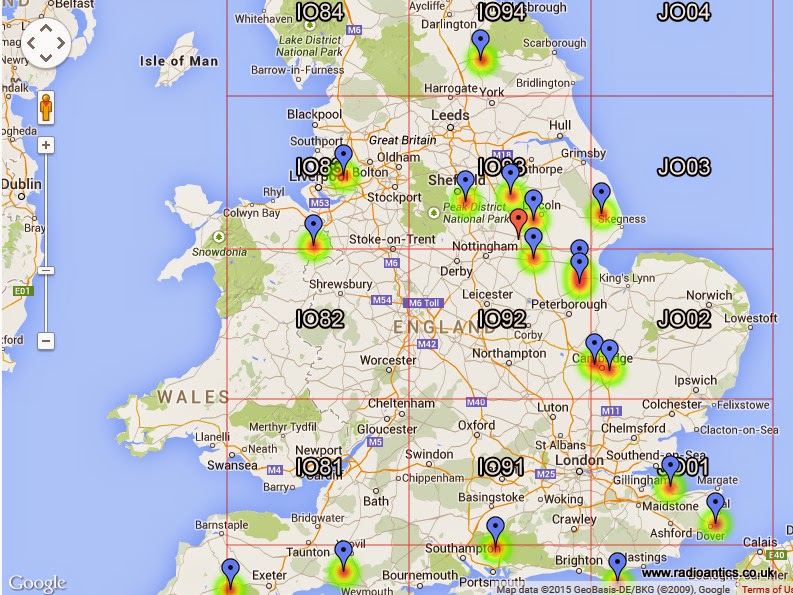 | |
| M0NRD QSO map March 144 VHF |
 |
| Noise across the band |












